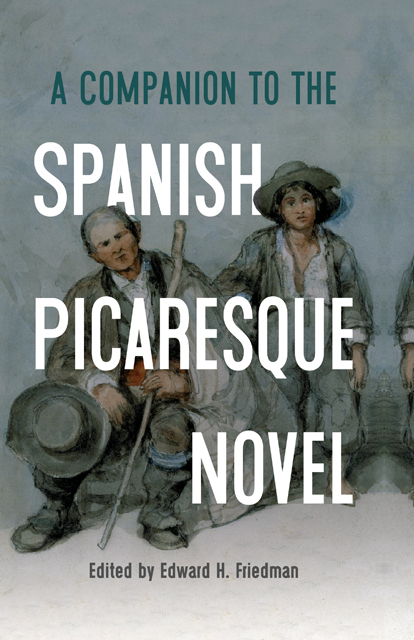Book contents
- Frontmatter
- Contents
- List of Illustrations
- List of Contributors
- Foreword
- 1 The Picaresque as a Genre
- 2 On the Picaresque and Its Origins
- 3 Francisco Delicado, La lozana andaluza
- 4 Lazarillo de Tormes
- 5 Mateo Alemán, Guzmán de Alfarache
- 6 Francisco de Quevedo, La vida del Buscón
- 7 La pícara Justina
- 8 Alonso Jerónimo de Salas Barbadillo, La hija de Celestina
- 9 Miguel de Cervantes and the Picaresque
- 10 Vicente Espinel, Marcos de Obregón
- 11 Carlos García, La desordenada codicia de los bienes agenos
- 12 Estebanillo González
- 13 Critical Approaches to the Picaresque
- 14 The Picaresque in Spanish America
- 15 Continuations: France and England
- 16 The Continuity of the Picaresque: Spain
- Bibliography
- Index
- Tamesis • Companions
9 - Miguel de Cervantes and the Picaresque
Published online by Cambridge University Press: 11 January 2023
- Frontmatter
- Contents
- List of Illustrations
- List of Contributors
- Foreword
- 1 The Picaresque as a Genre
- 2 On the Picaresque and Its Origins
- 3 Francisco Delicado, La lozana andaluza
- 4 Lazarillo de Tormes
- 5 Mateo Alemán, Guzmán de Alfarache
- 6 Francisco de Quevedo, La vida del Buscón
- 7 La pícara Justina
- 8 Alonso Jerónimo de Salas Barbadillo, La hija de Celestina
- 9 Miguel de Cervantes and the Picaresque
- 10 Vicente Espinel, Marcos de Obregón
- 11 Carlos García, La desordenada codicia de los bienes agenos
- 12 Estebanillo González
- 13 Critical Approaches to the Picaresque
- 14 The Picaresque in Spanish America
- 15 Continuations: France and England
- 16 The Continuity of the Picaresque: Spain
- Bibliography
- Index
- Tamesis • Companions
Summary
Miguel de Cervantes’s approach to the picaresque has literary influences which range from Fernando de Rojas’s La Celestina (1499) and the anonymous Lazarillo de Tormes (1554) to Mateo Aleman’s intricate Guzman de Alfarache, published in two parts, in 1599 and 1604. The picaresque genre evolved in numerous sequels, such as Francisco de Quevedo’s archetypal El Buscon, published in 1626 but circulated earlier. The most representative of Cervantes’s picaresque texts explore the genre in various ways. Cervantes’s picaresque spirit has been traditionally recognized in three of his 1613 Novelas ejemplares (Exemplary Novels): Rinconete y Cortadillo (Rinconete and Cortadillo), El casamiento enganoso (The Deceitful Marriage), and El coloquio de los perros (The Dialogue of the Dogs). In addition, a picaresque sensibility can be appreciated in Gines de Pasamonte, a character in the 1605 and 1615 volumes of Don Quijote de la Mancha. Finally, some picaresque texts were part of Cervantes’s 1615 Ocho comedias y ocho entremeses (Eight Plays and Eight Dramatic Interludes), including the plays Pedro de Urdemalas and El rufian dichoso (The Fortunate Ruffian), together with the dramatic interludes El retablo de las maravillas (The Marvelous Puppet Show), El rufian viudo (The Ruffian Widower), and El vizcaino fingido (The Man Who Pretended to Be from Biscay).
The popularization of the printing press facilitated the expansion of knowledge in the early modern period, allowing readers to access new realities, such as the existence and accounts of poor and ingenious individuals, which became particularly attractive. Celestina is a narrative in dialogue form about a go-between’s service to a wealthy couple, in which the feelings and aspirations of nonconformist servants are openly depicted for the first time in early modern Western culture. Conscious of their social class, Parmeno, Elisa, Sempronio, and Areusa dare to confront and question their masters, opening a hidden and refreshing literary territory, while keeping the subversive flavor of classical works such as Apuleius’s The Golden Ass (see Francisco Calero, “El Asno de oro”).
The narrative which originally inspired the picaresque genre is Lazarillo, whose subversive bent shows the influence of humanistic and Neo-Latin texts.
- Type
- Chapter
- Information
- A Companion to the Spanish Picaresque Novel , pp. 103 - 116Publisher: Boydell & BrewerPrint publication year: 2022



